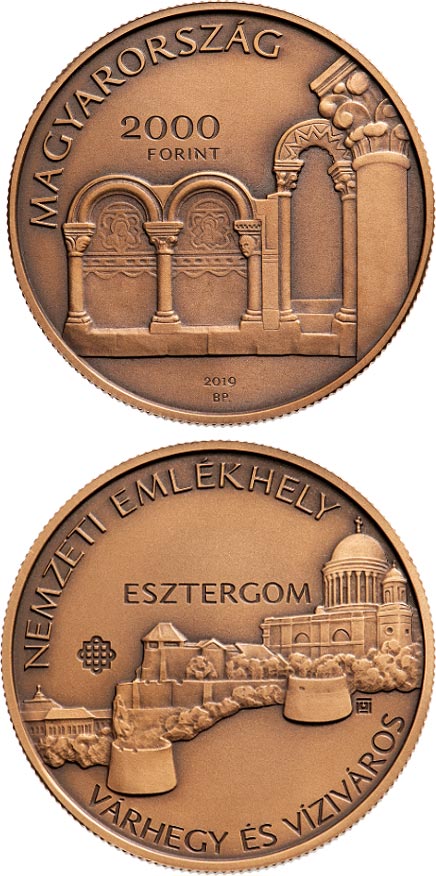2,000 forint - Esztergom, Castle Hill and Víziváros National Memorial Site
Series: Hungary - Commemorative 2000 forint coins

Budapest, 14 November 2019. – The Magyar Nemzeti Bank will issue a non-ferrous metal collector coin in a bronze coated finish, named Esztergom, Várhegy és Víziváros Nemzeti Emlékhely (Esztergom, Castle Hill and Víziváros National Memorial Site) with a face value of HUF 2000 on 15 November 2019, during the Nemzeti Emlékezet Konferencia (National Memory Conference) organised by the Hungarian Heritage Institute (NÖRI). The collector coin programme was launched at the initiative of the NÖRI in 2014. This issuance offers a valuable contribution to the series depicting the Hungarian national memorial sites and follows the presentation of Somogyvár-Kupavár, Mohács, the New Public Cemetery in Rákoskeresztúr, Fiumei Road Cemetery and the Parliament Building and its neighbourhood.
The collector coin issued in honour of Esztergom, Castle Hill and Víziváros National Memorial Site are legal tender in Hungary, but it does not serve circulatory purposes. Its primary function is to call attention to one of the most relevant memorial sites of Hungarian statehood and in the history of Christianity in Hungary.
The crucial role Esztergom played over the centuries was established by Géza, Grand Prince of the Hungarians, when he moved his seat to the town. His first son was born here, who was crowned here as Stephen (Stephen I of Hungary). Stephen founded 10 episcopacies in Hungary, headed by the Archbishop of Esztergom. Esztergom was the centre of royal power in Hungary until the middle of the 13th century. Counts had to take the taxes to Esztergom every year; however, the only mint company in the country was also located here. The town provided the venue for several congresses attended by kings. Here, Géza II of Hungary met with Louis VII of France in 1147,
and Béla III of Hungary received Frederick I, Holy Roman Emperor in 1189. The former royal castle is now a museum. Following the Mongol invasion, the town lost its functions as a governmental centre definitively, but continues to be the centre of the Hungarian Catholic Church to this day. Being the largest and first church in the ranking in the country, the Basilica of Esztergom was built where the cathedral stood in the Middle Ages. Surrounded by the Castle Hill, the Little Danube and the Danube, the stripe of land directly below the royal castle was called ‘archiepiscopal town’, but today it is known as Víziváros.
Here is the Primate’s Palace and the collections of the head diocese: the Library in the Main Cathedral, the Primate’s Archives, the Archiepiscopal Simor Library and the Museum of Christianity. Along with the other archiepiscopal collections in the castle area (the Treasury of the Main Cathedral, the Main Chapter Archives and the Theological College of Esztergom Library, a significant share of Hungary’s cultural heritage is kept in these buildings.
The collector coin named Esztergom, Várhegy és Víziváros Nemzeti Emlékhely (Esztergom, Castle Hill and Víziváros National Memorial Site) was designed by applied artist Zoltán Tóth.